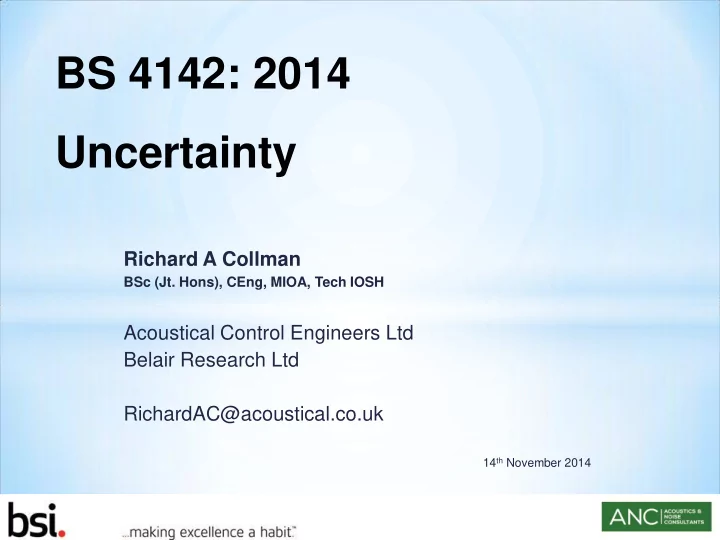

BS 4142: 2014 Uncertainty Richard A Collman BSc (Jt. Hons), CEng, MIOA, Tech IOSH Acoustical Control Engineers Ltd Belair Research Ltd RichardAC@acoustical.co.uk 14 th November 2014
10.1 General Consider the level of uncertainty in the data and associated calculations. Where the level of uncertainty could affect the conclusion, take reasonably practicable steps to reduce the level of uncertainty. Report the level and potential effects of uncertainty. Good practice, now explicit. Uncontroversial?
B.1 General Because this standard is not intended to provide a single numerical value against which the significance of a sound source can be determined, consideration needs to be given to the uncertainties involved in sound level measurements and subsequent assessment of data, together with the potential effects of such uncertainties on the outcome of the assessment. It is not appropriate to numerically estimate the uncertainty and simply make an allowance for this value in any assessment. Instead, an appropriate consideration of uncertainty based on professional judgement can enable an informed decision to be made regarding the likely significance of the impact of sound, whilst considering the range of likely levels and context of the assessment . Outcome range; Uncertainty effect on impact significance
Uncertainty of measured values Instrumentation uncertainty usually relatively small Many other, usually more significant, factors: * Complexity and relationship between specific & residual sounds * Locations of measurements, source(s), receiver * Measurement durations, times, number, conditions – weather/ operating, … * Technique/ competence: data recording (rounding, observations), parameters, …
Measurement Good Practice Good practice is essential: * Minimise instrumentation uncertainty * Minimise uncertainty & error in measured levels * Obtain representative measurements * Understand likely causes and magnitude of measurement uncertainty Annex B draws on the Salford Guide (Craven & Kerry 2007)
Good Practice Guidelines Consider: * Standing waves/ interference * Point/ line/ area sources – near & far field * Source: configuration, condition, height, location(s) * Weather: measurement effect, residual variability * Transmission path: ground effects, barriers/ foliage * Receiver: representative background, equipment reliability * Survey duration, reporting, data storage
Measurement variability Usually significant spatial and temporal variability * Select location(s) to control/ understand spatial effects * Select duration, timing, measurement quantity, conditions to understand temporal effects Highly variable level – greater uncertainty, longer measurement period Steady level – less uncertainty, shorter measurement period may be appropriate Interaction between residual and specific levels
Uncertainty in calculations Due to several factors: * Measured levels * Source variability * Calculation method * Modelling * Calculation error
Effect of measurement uncertainty on calculations Uncertainty in measured residual level introduces uncertainty when calculating specific level Varying residual/ specific levels exacerbate this uncertainty Consider effects on and minimise potential calculation uncertainty when preparing for and taking measurements
Effect of source variability on calculations Source level likely to vary in level and character Duration and possibly timing of different levels/ characteristics will affect specific levels Obtain sufficient data to properly understand and assess the effects of source variability
Effect of calculation method Use validated methods for calculations sound power levels, sound propagation etc. such as ISO 9613-2, BS EN ISO 374x If an alternative calculation method is used, fully describe the method and state the reasons for using this method.
Effect of modelling on calculations Any acoustic model is a simulation of reality and introduces additional uncertainty in addition to that of the calculation method e.g. how is a building/ bund modelled as a barrier? Ensure any modelling minimises additional uncertainty and consider as part of the assessment
Effect of calculation error Standard systems can reduce the likelihood of errors but do not guarantee their absence. Check the implementation of the calculation method for errors.
Effect of Uncertainty on Assessment Assessment result is a range, not a single value Magnitude of the range will depend not only on Uncertainty but other factors such as the variability of the residual and specific levels Uncertainty may be insignificant for a very clear assessment outcome, but may significantly affect the outcome if borderline
Precision or Accuracy? Precision often gives misleading impression of accuracy Sound levels quoted to nearest integer despite uncertainty of at least several dB Need to clarify these factors when reporting
Questions (if any remaining uncertainty)?
Recommend
More recommend